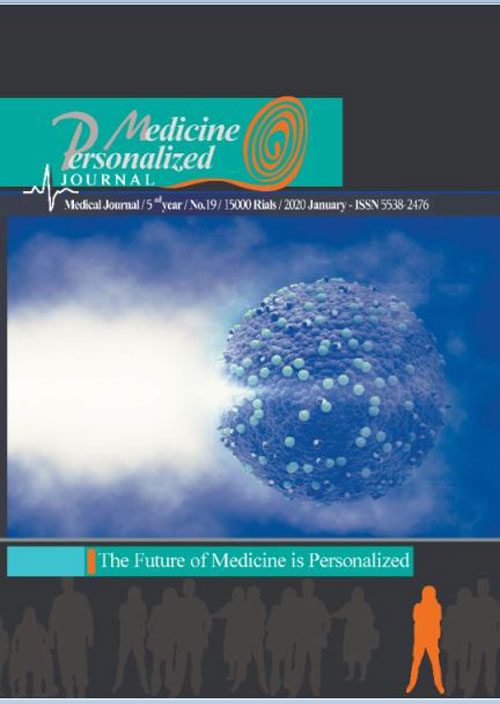فهرست مطالب

Personalized Medicine Journal
Volume:5 Issue: 19, Autumn 2020
- تاریخ انتشار: 1399/11/01
- تعداد عناوین: 7
-
Pages 1-3
Cervical cancer is the fourth most common and deadly cancer in women around the world. One of the genes associated with many cancers is the CYP1B1 gene. Some studies have shown that polymorphisms in the CYP1B1 gene can induce hyperactivation of proteins and increase the incidence rate of several cancers. In the present study, the association between the CYP1B1 C4326G polymorphism and the cervical cancer risk was examined with 60 newly diagnosed patients with cervical cancer and 60 cancer-free controls. DNA was extracted using the salting-out method, and the restriction fragment length polymorphism (RFLP) technique was used to determine the genotype of the CYP1B1 C4326G polymorphisms. The frequencies of the three genotypes (CC, CG, and GG) of CYP1B1 C4326G were 68.0, 25.4, and 6.6% for cervical cancer cases, and 73.1, 21.4, and 5.5 % for cancer-free controls. A significant difference was found between the two groups (χ2=7.41, P=0.02).
Keywords: Cervical cancer, CYP1B1, Salting-out, Human papillomavirus -
Pages 4-6
Chemokine CXCL9 is a member of the CXC family and plays an important role in the chemotaxis of immune cells. In this study, changes in the CXCL9 expression were investigated in prostate cancer and adjacent normal tissue. The prostate cancer tissues and the corresponding adjacent tissues used in this study were collected from 30 patients. The real-time quantitative PCR (qRT-PCR) was performed for evaluated changes in the CXCL9 expression in prostate cancer and adjacent normal tissue. The mRNA levels of CXCL9 in prostate cancer samples was greater than normal samples (P=0.04). The results suggested that the mRNA expression levels of CXCL9 were positively associated with prostate cancer.
Keywords: Chemokine, CXCL9, Prostate cancer, Gene expression -
Pages 7-9
Gastric cancer is the fourth most common cancer worldwide, and it ranks second leading cause of cancer deaths. Several studies have shown that FGL2 contributes to the pathogenesis of a number of infectious diseases. However, little is known about its biological functions in cancer development and metastasis. In this study, the association between FGL1 expression and prognosis was investigated in GC patients. Gastric cancer and adjacent normal tissues (n=20) were obtained from patients diagnosed with gastric cancer aged between 30 and 50. Total RNA was extracted, reverse transcription and qPCR were performed, and Relative expression level was calculated using the 2-∆∆Cq method. It was found that FGL1 expression in gastric cancer tissues was obviously higher than adjacent tissues at mRNA levels (P<0.003).
Keywords: Gastric cancer, FGL2 gene, gene expressionq, PCR -
Pages 10-12
The increasing literature exploring the role of circulating miR-210 has clarified its potential as a promising biomarker for early detection, diagnosis, and prognosis. Measuring circulating miR-210 levels could be a non-invasive method for early cancer detection. Even if, to date, most studies appear to be preliminary, it seems that miR-210 will be a good target for drug development. This study detected the difference in serum miR210 expression between healthy people and breast cancer patients. A total of 15 breast cancer patients were selected for a breast cancer (BC) group and 15 healthy people as a control group. The results showed that the expression level of miR-210 in the serum of breast cancer patients was significantly higher than controls. Patients with breast cancer showed increased levels of circulating miR-210, so circulating miR-210 may be a potential biomarker of tumor presence and therapeutic response to breast cancer..
Keywords: Breast cancer, Biomarker, miR-210, Gene expression -
Pages 13-15
Cervical cancer is the most widely screened cancer globally, both in high- and middleincome countries. HPV has been implicated in 99.7% of cervical squamous cell cancer cases worldwide. Viral E6 and E7 gene expression leads to alterations in the cellular genome integrity, including structural and numerical chromosomal instability resulting in chromosomal mis-segregation and aneuploidy. Centromere protein M (CENPM) is an essential centromere component for chromosome separation. In this study, the gene expression was evaluated at the mRNA level using the qRT-PCR method on 20 cancer samples previously infected with feather papillomavirus. The results show a significant increase in gene expression in cancer samples.
Keywords: Cervical cancer, Human papillomavirus, Chromosomal instability, CENPM Gene -
Pages 16-18
Nanotechnology involves the creation and manipulation of materials at the nanoscale to create products that exhibit novel properties. Titanium dioxide nanoparticles (TiO2-NPs), as one of the top five nanoparticles in annual production, are widely used in industries ranging from healthcare to drug delivery. The properties of TiO2-NPs have raised concerns regarding toxicity. Annexin V-FITC/PI double staining and a flow cytometer were used to detect apoptosis. A significant increase was observed in apoptosis at different concentrations of TiO2-NPs (50-100 µg/ml) varying between 25-40% apoptosis by 24 h. It is recommended that this study be performed in vivo to investigate the apoptotic and toxic effects of these substances further.
Keywords: Double staining, TiO2-NP, Hepatocellular, Apoptosis -
Pages 19-21
Diabetes mellitus (DM) is known as a major public health issue worldwide. Type 2 diabetes does not have a clear inheritance pattern, although many affected people have at least one close family member, such as a parent or sibling, who is affected with the disease. The KCNJ11 gene is a member of the potassium channel gene family. Polymorphisms in KCNJ11 (E23K, rs5219) result in neonatal diabetes and congenital hyperinsulinemia, which are associated with diabetes susceptibility where the K allele plays an important role in insulin secretion. This study evaluates the frequency of these polymorphisms in 85 Kurdish patients with type 2 diabetes. E23K polymorphism was genotyped by the PCRRFLP method. Heterozygous carriers for AG are more in non-diabetic patients (P = 0.034).
Keywords: Diabetes mellitus, Single nucleotide, polymorphism, Hyperinsulinemia, Biomarker


